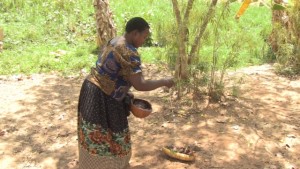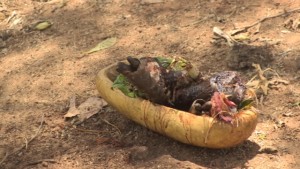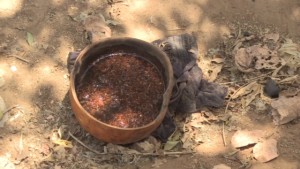I thought it was just the lack of TV that made our elders to tell us stories in the darkness of the night, mostly in the kitchen as supper cooked on a charcoal stove, a paraffin candle providing the only light, and our lips the only entertainment. But recently, on two occasions, I happened upon a group of children telling each other those same stories. One group was waiting to start rehearsals for a music dance, and since their teacher was late, they took to entertaining themselves. Another group was eating supper, and though all the lights were on, they still shared these stories. It pleased me that even as a plethora of TVs, radio stations, the internet, and all other forms of entertaining have flooded urban towns in Africa, these stories that I first heard as a child over thirty years ago continue to be told, orally, with the same effect on children. Sometimes horror, but mostly to generate a real big laugh.
When Margret approached me to contribute a story for the African Monsters anthology, I at once thought of three creatures that I kept hearing throughout my childhood. The one I eventually wrote about was my third priority, for in it I found a tale to fit the theme of the anthology. They did not want anything humorous, and that was a bit difficult, for as I’ve said above, the African monsters I know have comic elements. This might call for a bit of investigation into the correlation between horror and humor in the oral tales of Uganda (and maybe East Africa), maybe an academic paper of sorts, but I am not an academic, and so I’ll only list the monsters as I remember them.
I call the one in the book ‘monwor.’ In reality, that name does not exist, for these creatures are called different names in different places. Sometimes they are called genii, in the cultures influenced by Swahili, most times they are called by the word for spirit or ghost in a language, words like misambwa (Luganda) or yamo (Jopadhola). The story often goes of a man who picks up a woman in the streets, at night, and takes her home, or to a lodge. Then comes the punch line; the woman either she stretches her hand until it’s over twenty feet long to turn off the lights, or the man wakes up and finds his bed has been moved out maybe to a garden, maybe to a graveyard; or the man discovers that she has goat feet. I once heard of a man who picked up a woman on the highway, but just as she was about to enter his car, he saw that she had goat feet, and so he sped off in terror. A little way up ahead, he met a group of women. From their luggage, he thought they were traders returning home from a market, so were waiting at the roadside for a bus or kamunye (commuter taxi). After meeting the goat-feet woman, he was scared of driving alone. The nearest town was still ten miles away. He thought these women’s company would give him security and comfort, so he offered them a ride. On the away, he told them of the goat-feet woman, and then the woman on the seat beside him said; “You mean she had feet like this?” She lifted up her dress to show him a cute pair of goat feet.
I think these stories arose to discourage women from staying out at night, or maybe as urbanization grew to discourage prostitution. In the town I grew up in, they called the creatures ‘yamo’, a word for spirit. The mythology was that if you heard women laughing outside at night, they most likely were yamo, and if any woman knocked on your door in the dead of night, claiming to be lost, don’t let her in. If you did, and you served her food, chances are that she would eat everything, including the plates and forks and utensils, for spirits think all that is part of human food.
The creature I love the most is called an abiba, a witch, and she can fly, but not on broomsticks. She just flies, with fire blazing out of her anus. I don’t know if the fire is similar to the flames that jet out of a rocket, if they propel her forward, but the image of a flying witch with fire in her anus is hilarious. I have tried to write a story featuring this creature, and failed. It all comes out too funny. As a child, I heard of another version of an abiba, this time it was a man, but he was not flying. A neighbor claimed to have met him in the dead of the night, as she was heading back home. He was moving upside down, with his hands on the ground and his legs up in the air, and fire spurt out of his anus. Both stories came from Luo/Nilotic communities, with the abiba coming from West Nile region of Uganda, and the second one I heard from a Luo woman of Kenya.
Second to the abiba is the night dancer. In other places they are called night runners, but in Uganda we call them the night dancers, though every nation has its own word for these people. And they are people, ordinary people. I think they are afflicted with a form of sleep walking, in which the victim runs around the village paths or town streets, dancing stark naked. They are often benevolent, doing no harm other than throwing feces into your bed if you leave your window open, or throwing stones on your roof to keep you awake at night. They are often thought of as a nuisance. There are methods of trapping them. One is to plant razor blades on your door, because they are said to rub their naked bums on the doors while dancing. Once they do it the blades cut them. They bleed, leaving a blood trail back to their home, and hence their identity is revealed. There are also charms that you put around your house to hide time from the night dancer, and the dancer won’t know when the sun rises, so he will keep dancing until daytime. Then, his identity will be revealed. There are numerous accounts of people caught in this way. Often, it was someone from within the neighborhood, and often, it was a man. I don’t know why.
Closely related to the night dancers are abasezi (a term from Buganda, one of the nations in Uganda). They are cannibals who eat zombies – well, not the rotting corpses you see on TV, but a different kind of zombies. Today some people think night dancers and abasezi are the same, but while growing up tales of the night dancers were different from tales of the abasezi. A musezi (singular) will kill a person using charms. Once the dead person is buried, the corpse cannot rot, because the musezi will have charmed it. At an appropriate time, the musezi will perform magic, and the corpse will walk out of the grave to the musezi’s home. To be eaten. Or sometimes to work the gardens until the musezi eats it. In recent years, tales of abasezi have become so common that they regularly appear in the news. In some parts of Uganda, every month someone is arrested on suspicion of this kind of cannibalism. In a recent news article, a corpse refused to be eaten until the musezi buys it a phone – the article never explains why it wanted a phone.
Tales of abasezi are the most hilarious, and the most popular. A few months ago I was in South Africa, and a few Ugandans had gathered around a table. Someone started a tale, and we laughed so much that one girl fell to the floor holding her sides. There were Americans in the group, and a few south Africans. They never understood why we were laughing. We tried explaining the joke, but they only looked at us wondering what was funny. I think you need to have lived in Uganda to get it. It puzzles me. In many communities people live in constant fear of being eaten. Whenever a person dies, some families will perform extensive rituals to make sure the corpse doesn’t end up on a musezi’s plate, for no one can be certain whether the death was natural or the work of a musezi, so why is it fodder for comedy?
There are many other things in Uganda that don’t stay dead, especially corpses. We lived near a man who performed hearse services. He was of mixed racial origin, what they call ‘kosa kabila’ (those without a people). We feared him, and we feared his car, a pickup truck. I still remember the number plate. UUD 999. Some people thought the 999 was inverted 666, that this man was real evil. Whenever there was a death, he was the only one who would transport the corpse. His children told us wild stories that they claim he told them. Often, before setting off on the journey, he would put four eggs on the road for each tire to roll over as sacrifice, but some corpses wouldn’t accept this sacrifice. Then his car would break down. Sometimes, the car would just stop moving, for no mechanical reason. Sometimes, they would have to call a shaman to perform rituals to appease the corpse to allow the car to move. Other times, he would get angry, grab a stick, and whip the corpse and it allows them to transport it. Today there are several professional funeral services in the city, but tales like this persist. I recently saw news of mourners who had to whip a corpse because it wouldn’t allow them to transport it, they whipped it so bad that the flesh got torn in some places, and only then did their car move.
Other undead things include mukalabanda (a walking skeleton) and a mizumu (ghost). But tales of ghosts are not so common, I don’t know why, maybe because of ancestral spirit worship, and the idea of ghost as seen through Western/Christian/Islamic eyes has not gotten real roots. If you encounter one its sometimes not a bad thing. Ghost tales do the rounds occasional, but they are not as popular as tales of evil spirits, which include mayembe, a spirit that is sent to cause trouble. Sometimes, like the night dancer, it announces its presence by throwing stones onto tin roofs. Most times, whips victims with invisible sticks. Many people use it to drive off rivals in land disputes. Some people use it to torment those they have grudges against, either with sicknesses, or bad dreams, or sleepless nights – it can haunt a house the way a ghost will haunt a house. About a decade ago, I read a news article about a woman who went to a shaman in Tanzania to get a mayembe. She intended it to disrupt a family, so that the man can chase away his wife and marry her instead. On returning home, she found the wife had already run away, so she released the mayembe thinking it was of no more use. However, the mayemba went on rampage, raping several women in the village before the shaman came to arrest it.
The most feared evil spirit is kifaro. It is essentially an assassin. You use it to kill your enemies, or rivals, or people you don’t like. Other than kill, it can cause severe sicknesses, or disability, or madness. I have seen one such thing, in a calabash. It was a cock’s bloodstained head and a lot of other ingredients. A shaman was kind enough to show it to me. There are two kinds of shamans here, the good kind, who heal, and are sometimes called herbalists, and the evil kind, who use things like kifaros and mayembes. Colonialism, Christianity and Islam mean they are all called witchdoctors, but in every nation there are two names for shamans, one to denote a do-gooder and another to denote the evil doer.

In Uganda, the evil kind are notorious for child sacrifice, which gives us another kind of monster. Head hunters. Children in Uganda are traumatized, for a few years back stories of children mutilated in ritual sacrifice was a very common headline. One newspaper was notorious for showing gross pictures of severed heads and dismembered bodies. But while I was growing up, we only heard about these head hunters in whispers. This is one tale that was rarely told in humor. It would chill our bones, and it made us terrified of strangers. They always ended with a; ‘If you walk out alone the headhunter will kidnap you and put you in a sack.’ It’s an image that has lived with me all my life, a chloroformed child in a jute sack on the back of a headhunter, who calmly walks through crowded streets with no one knowing what is in the sack.
Often they would warn us to beware of strangers, of people you don’t know, of the obibi, which is another monster, but this time from the folk tales of Acholi (my mother’s people). Nobody knows what the obibi looks like. There are other names for it in other languages, but all stories have it as resembling human beings. In some stories it comes in the shape of a handsome man. In other stories, he is a kind of shape shifter, turning into a beast just before devouring his victims. Unlike the shape shifters in Western mythology, like the werewolf, that eat raw flesh off a living being, the obibi will often use tools and even sometimes cook his victims before dining. In one story, a victim hears him sharpening a knife as he chants a song that transforms him from man to beast. In another story, the obibi is a mother whose daughter Lapogo has a friend called Kila. Min Lapogo (Lapogo’s mother) encourages her daughter to invite Kila to stay with them, and when Kila does, Min Lapogo turns into a hyena at night and drinks Kila’s blood (a mix of werewolf and vampire, I think).
There are other monsters, many other monsters, that might require a whole book to discuss, but one of the most memorable is the nyawawa. It’s not exactly a monster as much as it is ancestral spirits, or maybe ghosts, that roam around a neighborhood. When they come, people are supposed to make so much noise to scare them away, otherwise they will possess your house. Housewives then, lacking drums, beat saucepans, jerry cans, any household item, so crazily so that the demons fear to come into their home. This is mostly found in Western Kenya, a few miles from where I grew up, and we kept hearing stories of how welders, metal workers, and other jua kali craftsmen who mend broken household utensils could sometimes provoke people into thinking that nyawawa is attacking. The next day, they are sure to find a long line of housewives with broken pans and cans that need fixing.


